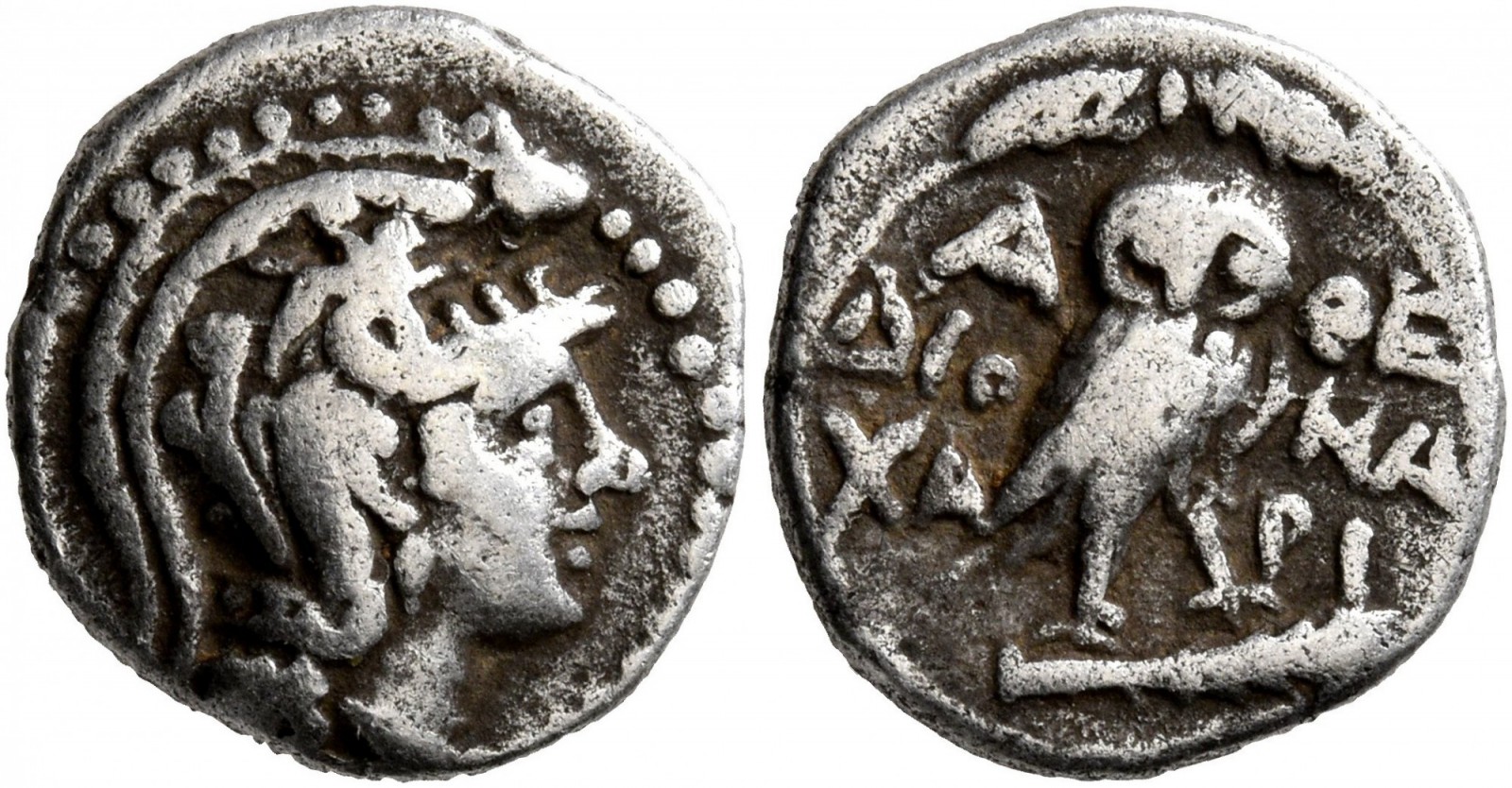H 163 - Athens, silver, hemidrachms (185-135 BCE)
From SILVER
185 BCE - 135 BCE Silver 386 kg
Description
| ObverseInscription or printing placed on the obverse.: | Head of Athena Parthenos right, wearing crested Attic helmet with Pegasus, aplastron and front part of horses. Border of dots. |
| ReverseInscription or printing placed on the reverse.: | ΑΘΕ (Greek).Owl standing facing on club, all within wreath. |
Mint and issuing power
| MintIdentifies the place of manufacture or issue of a numismatic object.: | Athens | Ancient regionAncient region.: | Attica | Modern countryModern country: Greece | AuthorityIdentifies the issuing power. The authority can be "pretended" when the name or the portrait of X is on the coin but he/she was not the issuing power. It can also be "uncertain" when there is no mention of X on the coin but he/she was the issuing power according to the historical sources: |
Chronology
| FromIdentifies the initial date in a range assigned in a numismatic context. | 185 BCE | toIdentifies the final date in a range assigned in a numismatic context.. | 135 BCE | PeriodTime period of the numismatic object.: Hellenistic 323-30 BC |
Physical description
| MetalThe physical material (usually metal) from which an object is made.: | Silver |
Median weightMedian of the weights of numismatic objects (in grams). in grams | 2.00 | DenominationTerm indicating the value of a numismatic object. Examples: tetradrachm, chalkous, denarius.: | hemidrachm |
StandardStandard.: | Attic |
Image

H163 Athena Parthenos.jpeg [1]
References
| Die study referencePublication of the study: | Thompson 19611Thompson 1961 | ||
| Coin series referenceReference to coin series study: | Sear I2Sear I, n° 2561, RQEMH3RQEMH, n° 163 | ||
Obverse dies distribution
| FrequencyFrequency of specimen in distribution. ᵖ | Number of obversesNumber of obverse dies. ᵖ (o) | % (o) | Number of coinsNumber of coins. (n) | % (n) | Die nameName(s) of the die(s). |
| 1 | 3 | 37.5 | 3 | 10.71 | 18, 226, 314 |
| 2 | 2 | 25 | 4 | 14.29 | 227, 313 |
| 4 | 1 | 12.5 | 4 | 14.29 | 312 |
| 5 | 1 | 12.5 | 5 | 17.86 | 329 |
| 12 | 1 | 12.5 | 12 | 42.86 | 328 |
| Total | 8 of 8 | 100 | 28 of 28 | 100.01 |
Reverse dies distribution
no distribution is available
Quantification
| Number of obversesNumber of obverse dies. ᵖ (o) | 8 | Number of singletons (o1)The number of singleton coins. ᵖ | 3 |
| Number of reverse diesNumber of reverse dies. (r) | 11 | Number of coinsNumber of coins. (n) | 28 |
| Coins per obverse dieNumber of coins per obverse die. (n/o) | 3.5 | Coins per reverse dieNumber of coins per reverse die. (n/r) | 2.55 |
| Reverse per obverse ratioRatio of obverse dies divided by reverse dies. (r/o) | 1.38 | Percentage of singletons (o1)number of coins (n) divided by the number of singletons (o1) ᵖ | 37.5 % |
| Original number of dies (O) (Carter 1983 formula)The estimation of the number of coins according to Carter 1983 ᵖ | 9.66 | Coins struck if 20,000 as average productivity per dieCoins made if the average productivity for obverses (according to Carter) is 20,000. ᵖ | 193,200 |
| Original number of dies (O) (Esty 2011 formula)The estimation of the number of coins according to the singleton formula in Esty 2011 ᵖ (O) | 11.2 | Survival rate if 20,000 as average productivity per dieSurvival rate if average productivity is 20,000. ᵖ | 0.00014 |
| Coverage (o = % of O) (Esty 1984 formula)Esty 1984 - coverage (% of O) ᵖ (o = % of O) | 89.29% | Die productivity if survival rate 1/2,000Average productivity if survival rate is 1/2,000. ᵖ | 5,797.1 |
| Weight of silver (in kg) if 20,000 coins per die (O = Carter formula)Carter 1983 * Median weight * 20000 (*10 if gold or electrum) ᵖ | 386 kg <br /> 386 kg | Die productivity if survival rate 1/5,000Average productivity if survival rate is 1/5,000. ᵖ | 14,492.75 |
Remarks
Most likely one single workstation